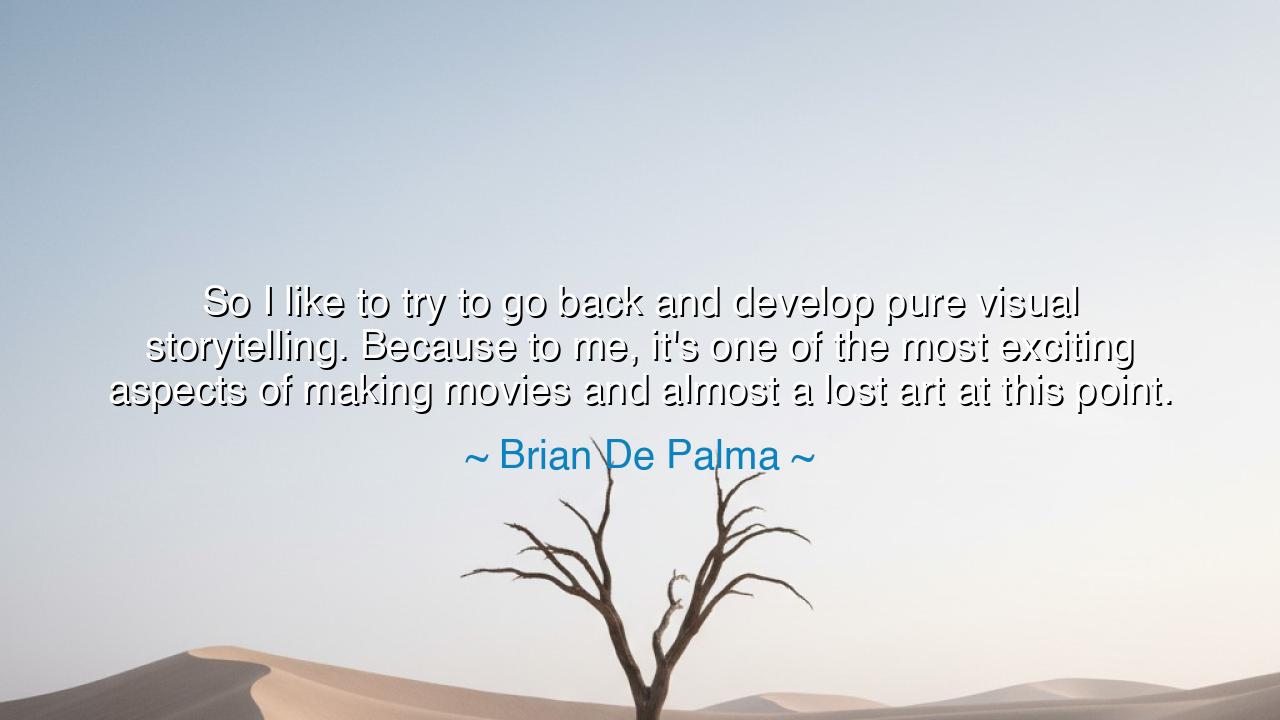
So I like to try to go back and develop pure visual
So I like to try to go back and develop pure visual storytelling. Because to me, it's one of the most exciting aspects of making movies and almost a lost art at this point.






Hear now the words of Brian De Palma, master of image and disciple of cinema’s earliest visionaries: “So I like to try to go back and develop pure visual storytelling. Because to me, it's one of the most exciting aspects of making movies and almost a lost art at this point.” In this confession lies both lament and hope, a recognition that amidst the flood of words and noise, the sacred power of the image has been forgotten, and yet it calls us back with irresistible force.
In the dawn of the art form, before sound filled the theaters, the movie spoke only with light and shadow. The faces of Chaplin and Keaton, the trembling hands of Gish, the sweeping battles of Griffith—these were voices made not of language but of gesture, movement, and silence. The people laughed, wept, and dreamed without a single word spoken, for the eye is the oldest witness, and pure visual storytelling speaks to the heart without need for translation. It is the tongue of all nations, understood alike by king and beggar, child and sage.
De Palma’s yearning is a call to return to the lost art, to strip away the clutter and return to the root. Just as the ancients sought wisdom not in abundance but in essence, so too does he seek storytelling not in endless dialogue but in the power of sight itself. For when the image speaks, it cannot be silenced by doubt; it pierces directly into the soul, unmediated by argument. A soldier raising a flag, a mother reaching for her child, a single tear upon a dust-stained cheek—such visions require no explanation, for they are truth made visible.
Consider, O listener, the tale of Sergei Eisenstein, whose Battleship Potemkin shook the world in 1925. His famous “Odessa Steps” sequence, with the baby carriage tumbling amidst chaos, spoke louder than any speech or proclamation. Nations trembled, for the power of the image carried both terror and beauty, rallying hearts to action. There were no long words, no elaborate explanations, only pure visual storytelling—and yet the world understood. This is the lineage from which De Palma draws, and the inheritance he urges us not to forsake.
Yet in our age, where noise and chatter multiply, where dialogue often drowns the silent power of the frame, the visual language grows weak, as though neglected by those who no longer trust the image to carry meaning. De Palma warns us that this art, once the soul of cinema, is fading, becoming “almost lost.” His voice is not condemnation but exhortation: to remember, to revive, to reclaim what gave movies their original power.
The lesson is clear: do not mistake words for truth alone. In your own life, learn again to see. Pay attention to the images that surround you: the posture of a friend, the color of the evening sky, the silence in a room heavy with unspoken grief. These are stories without words, but they are no less profound. If you are a creator, let your art breathe in silence and vision; if you are a seeker, learn to read the world not only with your ears but with your eyes.
Therefore, O traveler of time, let this wisdom guide you: reclaim the lost art of seeing. Strive not always to speak or explain, but to show. Let your deeds be images that inspire others without need for endless justification. For just as cinema was born from pure visual storytelling, so too can your life become a story told not only by what you say, but by what you reveal in action, in presence, and in truth.
So remember: a thousand words may fade, but a single image endures. Trust in the power of the visual, as De Palma has counseled, and let your story shine forth, not in noise, but in light.






AAdministratorAdministrator
Welcome, honored guests. Please leave a comment, we will respond soon